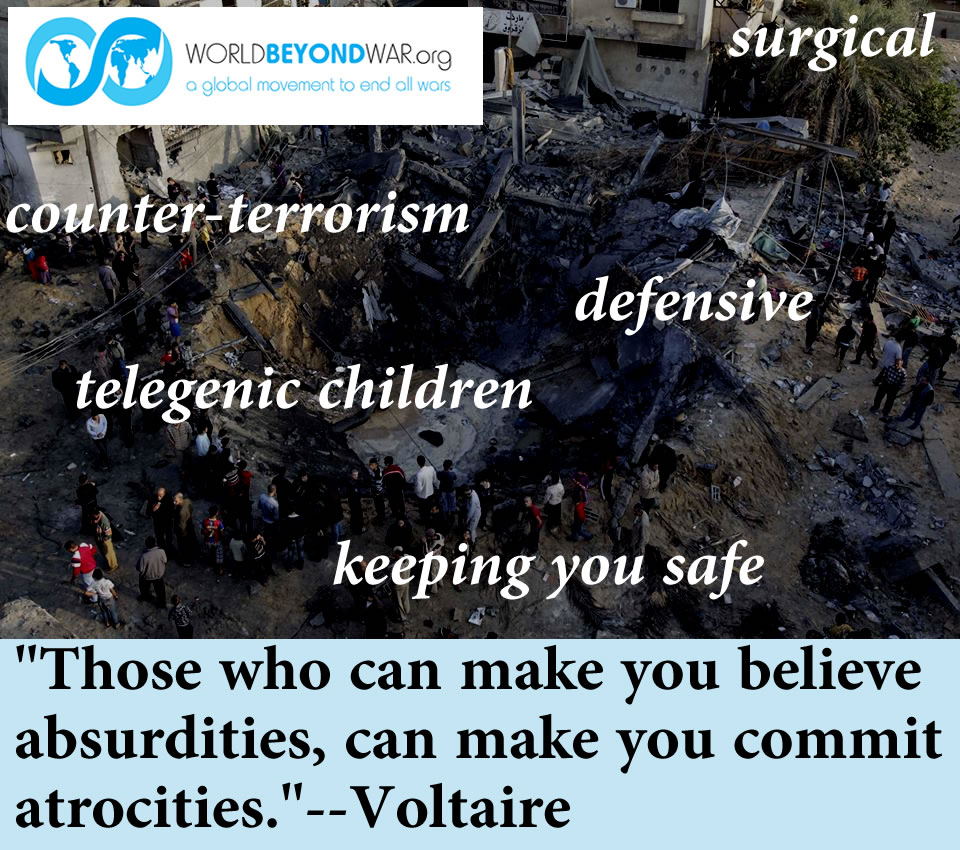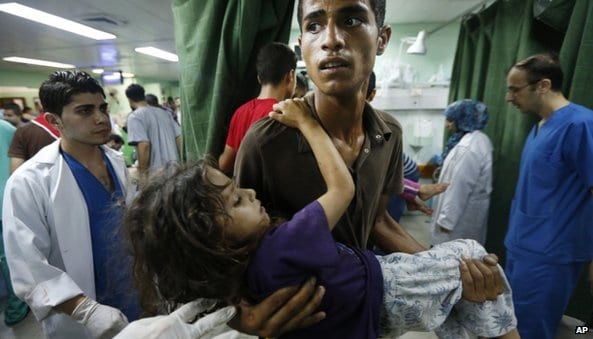“You need an event along the scale of the current event in order for you to be able to go in. After all, had we gone into Gaza three months ago, out of the blue, everyone would have said: Why are you entering Gaza?”Israeli finance minister, Yair Lapid, July 19, 2014 [1]
By Stephen Gowans
[T]he most recent eruption of Israeli military aggression against the Palestinians of the West Bank and Gaza, and the Palestinians’ consequent retaliation, is part of a permanent war of Zionist aggression against Arabs in Palestine that began soon after the UN promulgated its partition plan for Palestine on November 29, 1947. Formulated over the vehement objections of the Arabs, the plan allocated 56 percent of Palestine to a Jewish state, though Jews made up only one-third of the population and owned only six percent of the land, and 42 percent of the land to the Arabs, who made up the majority.
By May 15, 1948, when Jewish settlers proclaimed the state of Israel, the Zionist colonial project, through war and ethnic cleansing, had placed four-fifths of Palestine in the hands of Jewish settlers, and created a refugee population of 700,000 Arabs, displaced to Gaza, the West Bank, Lebanon, Syria, Jordan and beyond. Today, the Palestinian exile and diaspora community stands at five million, many leading lives—66 years after the Nakba, or day of catastrophe— of forced idleness in teeming refugee camps. In 1967, Israel brought Gaza and the West Bank under its military control, at the same time conquering Syria’s Golan Heights and occupying Egypt’s Sinai Peninsula (since returned to Egypt in exchange for Cairo’s absorption into the US orbit and cooperation with Israel.)
The Palestinians who live within Israel—or occupied Palestine ’48, in the terminology of the Palestinian resistance—have formal rights, but live de facto existences as second class citizens, non-Jews in the Jewish state. Meanwhile, their co-nationals in Gaza and the West Bank, the divided one-fifth of Palestine that is supposed to become the Palestinian side of the two-state solution, lead stifled lives under the heel of the Israeli military. Gaza, the most densely populated territory on the planet, is an open-air prison, its population subjected to an ongoing siege. The West Bank, as Jerusalem, is a stage on which a drama is played out daily of creeping annexation, as Israeli settlements snake out into the remaining Palestinian land, enlarging the frontiers of the Jewish state. What’s left of Palestine, for the endlessly promised Palestinian state which never materializes, is about one-tenth of the land Palestinians began with, before Zionists launched their project of expelling the occupants to make way for Jewish settlers.
There are three days of infamy in the Palestinian calendar.
• November 2, 1917, when the British foreign secretary , Arthur Balfour, whose country had conquered Palestine from the decaying Ottoman Empire, promised the land of one people (the Arabs) to another (the Jews.)
• November 29, 1947, when the UN promulgated its partition plan, effectively denying Palestinians the right of self-determination, and promising the better and best parts of Palestine to a Jewish state.
• May 15, 1948, the Nakba, or proclamation of the state of Israel on four-fifths of Palestinian territory, more than even the indefensible UN partition plan had envisaged.
Nakba Day 2014 saw two Palestinian youths killed by Israeli soldiers while commemorating the anniversary of the catastrophe. Video footage captured the last moments of the life of 16 year-old Nadim Siam Abu Nuwara. Walking placidly, he suddenly falls to the ground, his life extinguished by an Israeli army bullet. [2] Unlike the abduction of three Israeli settler youths, to come only weeks later, this event was barely registered in the Western media.
Meanwhile, Hamas, the Islamic resistance movement that governs Gaza, was abiding by a cease-fire agreed to with Israel which had held for 20 months. Hamas hadn’t fired a single rocket since the last Israeli army attack on the territory in November 2012, the eight-day Operation Pillar of Defense, which killed 167 Palestinians and left six Israelis dead, emblematic of the gross imbalance of casualties in Israeli-Palestinian confrontations. [3]
Hamas had agreed to a unity pact with Palestinian Authority president Mahmoud Abbas in April, after a seven year rift. Israel and its arms supplier the United States—Washington gives the settler state $3 billion in military aid yearly, more than it gives any other country—had reacted angrily to the accord, excoriating Abbas for forging a deal with Hamas. Tel Aviv and Washington oppose Hamas above all else because the resistance group—which blends religious, military, political and social welfare functions—refuses to recognize the Zionist dispossession of Palestinians as legitimate.
Whether Hamas is a terrorist organization—as it is demonized by Israel and Western governments— is a matter of definition. Washington arbitrarily excludes states from its own (and therefore mainstream) definition of terrorism, thereby sanitizing the Pentagon’s and CIA’s violence against non-combatants. No matter how many civilians the United States terrorizes through drone strikes, carpet bombing, “shock and awe”, threats of nuclear annihilation, assassinations and air wars, it cannot, by its own definition, be burdened with the label “terrorist”, since Washington conveniently deems terrorism to be the exclusive preserve of sub-state actors. But surely, what ought to matter in any definition of terrorism is not who uses violence, but the purpose for which violence is used (political change) and who it’s used against (non-combatants.) If we drop the arbitrary provision that terrorism is purely a phenomenon of sub-state actors, and define terrorism as political violence aimed at civilians, then, to be sure, Hamas is a terrorist organization. But so too are the states of Israel and the United States.
Were Palestinian resistance organizations to renounce violence, could they effectively resist the oppression of a racist, settler, colonial, occupation state and oppose the creeping annexation of the remaining Palestinian territory? How many could honestly say that the French Resistance ought to have renounced the use of violence against German occupation of French territory during WWII? Anyone who counselled this would have been justifiably accused of encouraging capitulation. The demand that Hamas renounce violence is no different. It is a demand that Hamas give up its resistance, accept the dispossession of the Palestinians, and endorse the denial of Palestinian self-determination.
Elaborating on this theme, As’ad AbuKhalil writes:
Acts of resistance against Nazi occupation in Europe (are) remembered with fondness and admiration and no one questions the methods even when innocent civilians were killed. Even in the struggle against apartheid South Africa, Americans refrain from questioning the methods in which collaborators were dealt with (necklacing, for those who remember). Yet, the Palestinians are asked…to achieve the impossible: to adhere to standards of combat that no armies and no liberation movements have ever adhered to. [4]
Referring to demands that Hamas refrain from operating inside populated areas, AbuKhalil rejoins: “This is like asking the members of the French resistance in WWII to live away from population centers and to concentrate in an open field to facilitate their elimination by [the] German air force.” [5]
Israel sanctimoniously places itself on a higher moral plane than Palestinian resistance groups, arguing that unlike its adversaries who fire missiles into civilian areas, Israeli attacks are never intended to harm non-combatants. That’s debatable. But even were it true that Israel intends no harm to civilians, the reality is that Israeli military operations have produced many times more civilian casualties than the Palestinian resistance ever has. If minimizing harm to civilians is valued, then we should be far more accepting of Hamas’s ‘terrorism’ than Israel’s allegedly international humanitarian law-compliant military campaigns.
The Palestinian Authority’s Mahmoud Abbas has gone a long way to acceding to Western demands to live peacefully with his oppressor, carrying out what some would call a program of collaboration. The kindest description of Abbas’s conciliation with Zionism—he says Arabs should never have rejected the UN’s 1947 partition plan, [6] concedes that Palestinians have no claim to the greater part of Palestine occupied by Jewish settlers before 1967, [7] and would deny the right of Palestinians to return to the homes they were dispossessed of in what is now Israel [8]—is that it’s based on the belief that 10 percent of a loaf is better than none. But the so-called peace process—to which Abbas is committed— goes nowhere. It has, instead, turned out to be a delaying tactic used by Israel to devour more Palestinian territory through the construction of new settlements and expansion of existing ones.
Abbas’s unity pact with Hamas was a retaliatory strike at Israel’s play-acting at negotiating. But with one of the world’s largest militaries, Israel is hardly motivated to negotiate. Backed militarily and diplomatically by the world’s hegemonic power, Israel has overwhelming bargaining power. Why would it make even a millimeter’s breadth concession? Better, in the view of the settler state, to use its US-supplied military machine to crush resistance and advance its colonial-settler agenda.
Netanyahu kicked off his new campaign to squeeze Hamas—or “mow the grass”, an Israeli reference to regular offensives against Palestinian resistance—by cutting off the $100 million of monthly tax revenue it collects on the Authority’s behalf. [9]
Next, Tel Aviv ordered a June 11 airstrike on Gaza, violating the ceasefire, negotiated after the November 2012 Israeli assault on Gaza. Netanyahu said the airstrike was targeted at a Hamas police officer who had been involved in numerous rocket attacks against Israel. “This is the true face of Hamas,” thundered the Israeli prime minister. “It is continuing to plan terrorist attacks against Israeli citizens even as it is inside the Palestinian government.” [10]
To intensify pressure, Israel announced it would build 1,500 new housing units in Jewish settlements in the West Bank and East Jerusalem, “saying it was retaliation for the creation of a Palestinian unity government with the militant group Hamas.” Israel’s housing minister Uri Ariel called the new construction—illegal under international law—”an appropriate Zionist response to the Palestinian terrorist government. I believe that these homes will be just the beginning.” [11]
On June 12, Israel was handed a pretext to further heighten its crackdown on Hamas. Three Israeli youths, Eyal Yifrach, 19, and two 16-year-olds, Naftali Frankel and Gilad Shaar, were abducted in the West Bank. Netanyahu immediately accused Hamas of kidnapping the teens. While Hamas welcomed the abductions, as did other Palestinian resistance organizations—on grounds that the youths could be used to bargain for the release of Palestinian political prisoners in Israeli jails—it denied that it had carried out the abduction. That didn’t deter Netanyahu. Producing not a speck of evidence to substantiate his claim, the Israeli prime minister insisted Hamas was responsible. Netanyahu, it should be noted, has a long record of fabrication in the service of political goals. As a parliamentarian, the future prime minister announced with utmost certainty that Iran was only three to five years away from making a nuclear weapon. That was in 1991. [12] In 2002, Netanyahu testified before the US Congress that: “There is no question whatsoever that Saddam is seeking and is working and is advancing towards the development of nuclear weapons–no question whatsoever.” [13] And now there was no question whatsoever that Hamas had abducted the three teens. And yet, Israel has yet to arrest any suspects. [14]
The outcome of Israel’s military offensive was consistent with an operation to degrade Hamas more than it was a police operation to locate abductees. The Israelis abducted 640 Palestinians, including Hamas’s top West Bank leadership, but charged none of them with kidnapping the three youths. They re-arrested and re-sentenced 75 Palestinians previously released in a 2011 prisoner exchange for Israeli soldier Gilad Shalit. They raided 1,000 homes, universities and other facilities, including 10 Hamas-run institutions. And they heaped punishment on Palestinian political prisoners, subjecting them to extra cruelties, including cutting back on visits from their families. Additionally, they killed five Palestinians, and imposed restrictions on Palestinian exit from the West Bank to Jordan and Gaza, at the same time limiting travel around Hebron. [15] Israeli Brigadier General Moti Almoz explained on July 8 that: “We have been instructed by the political echelon to hit Hamas hard.” [16]
But hitting Hamas hard also meant hitting the broader population hard, that is, collective punishment. This was a reality the Israeli army acknowledged, and welcomed. A senior Israeli army commander told the Wall Street Journal:
There is a dilemma of how much pressure to put on the terrorists themselves and how much to put on the population. I think the Palestinians understand the situation: Someone did something outside the rules of the game. If there is kidnapping in Hebron, then they will suffer. [17]
This, by the way, meets the definition of terrorism considered above, namely, visiting misery on a civilian population to create pressure to bring about a desired political goal. It is the terrorism of the oppressor.
With Hamas’s senior West Bank leadership locked up in Israeli jails, the offensive now turned to Gaza, a Hamas stronghold. The impact has been devastating. From July 8 to July 21 [18]:
• 584 Gazans were killed;
• 3,650 were injured;
• More than 1,134 homes were completely or partially demolished;
• 67 mosques were completely or partially destroyed;
• Property damage was inflicted on:
o 14,500 homes;
o 81 schools;
o 5 health centers;
o 3 hospitals;
• 100,000 were displaced;
• 900,000 were affected by the destruction of electricity, water and waste water infrastructure.
Over the same period 25 Israeli soldiers were killed and two Israeli civilians died by rocket and mortar fire. [19] The destruction continues.
US and Israeli political figures justified the carnage by pointing to Palestinian rocket attacks. Defending the Israeli massacre in Gaza, US president Barack Obama said “no nation should be subjected to a hail of rockets or underground incursions.” [20] He didn’t say that no nation should be subjected to 66 years of dispossession, abridgment of its rights, ethnic cleansing, repression, occupation, and racism.
Former Israeli ambassador to the United States, Michael Oren said: “It’s very difficult to feel compassion for the other when you have rockets aimed at your family.” [21] He didn’t say it’s very difficult to feel compassion for the other when he has stolen your land and made you a refugee.
What’s the solution? It’s not two states. Palestinians don’t accept it, and nor should they. According to a survey conducted from June 15-17 by the Washington Institute for Near East Policy:
• 70 percent of Palestinians in Gaza and the West Bank believe that the Palestinian national goal for the next five years should be reclaiming all of historic Palestine or establishing one state in which Arabs and Jews have equal rights.
• Two-thirds believe that even if a two-state solution is successfully negotiated that efforts should continue to liberate all of historic Palestine from Zionist control. [22]
Officials of the settler state know that Palestinians will never accept the permanent colonial war against them and accordingly count on Abbas and other Palestinian conciliators to accept crumbs from the Zionist feast on Palestine and ride herd on Palestinians who object to the selling off of their rights. Abbas and company accept a two-state solution because they think it’s the only measure of independence that can be practicably secured. This, however, is unrealistic. First, Israel evinces no genuine interest in accepting even a tiny Palestinian state on a small fraction of the land Palestinians originally inhabited before the ethnic cleansing of 1948. Instead, Tel Aviv uses on-again-off-again negotiations over a two-state solution to gradually devour more of Palestine. Secondly, two states—a large, militarily powerful Jewish state occupying the better and best parts of Palestine dominating a tiny, fractured Palestinian state—will never mollify Palestinians and slake their thirst for justice. A resistance will continue, even if a Palestinian state is negotiated, as the polling data above indicate. No justice, no peace.
The solution–if it can be put that way, or inevitable outcome if it can be put another–is a single, secular, democratic state, in which all are accorded equal rights, regardless of religion or national origin—not a racist state, not a Jewish state, but a democratic one. This is a moral, just, and democratic alternative to the plague of a racist, settler, colonial ideology of dispossessing indigenous people, driving them into exile, denying them the right of return, and blocking their right of self-determination. The solution to Zionism is the same as the solution to fascism: its repudiation and conquest by democracy.
NOTES
[1] Anne Barnard and Jodi Rudoren, “Despite Israeli push in Gaza, Hamas fighters slip through tunnels”, The New York Times, July 19, 2014.
[2] Ramzy Baroud, “Israel awakens the Palestine it tried to crush”, The Palestine Chronicle, July 11, 2014.
[3] J.J. Goldberg, “How politics and lies triggered an unintended war in Gaza,” the Jewish Daily Forward, July 10, 2014.
[4] As’ad AbuKhalil, “Western standards of Palestinian justice,” Al Akhbar, July 22, 2014.
[5] Ibid.
[6] “Arab rejection of ’47 partition plan was error, Palestinian leader says”, The Associated Press, October 28, 2011.
[7] Joel Greenberg, “Israel’s Netanyahu cool to Abbas’s hint at waiving Palestinian ‘right of return’”, The Washington Post, November 4, 2012.
[8] Joshua Mitnick, “Abbas signals flexibility on Palestinian refugees”, Wall Street Journal, Feb. 16, 2014.
[9] Nicholas Casey, “Palestinian unity deal creates stir in Middle East”, The Wall Street Journal, May 2, 2014.
[10] Isabel Kershner and Fares Akram, “Israeli airstrike in Gaza strip kills Palestinian”, The New York Times, June 11, 2014.
[11] Nicholas Casey, “Israel plans expanded settlement in retaliation for Palestinian government with Hamas,” The Wall Street Journal, June 5, 2014.
[12] Scott Peterson, “Imminent Iran nuclear threat? A timeline of warnings since 1979, ”The Christian Science Monitor, November 8, 2011.
[13] Peter Hart, “Netanyahu can disinform on Iran just as well as Iraq,” FAIR, June 23, 2014.
[14] Nicolas Casey, Tamer El-Ghobashy and Joshua Mitnick, “Israel launches ground invasion of Gaza”, The Wall Street journal, July 18, 2014.
[16] J.J. Goldberg, “How politics and lies triggered an unintended war in Gaza,” The Jewish Daily Forward, July 10, 2014.
[17] Nicholas Casey, “Hebron bears brunt of Israel’s search for missing teenagers”, The Wall Street Journal, June 20, 2014.
[20] Jodi Rudoren, “A push into Gaza, but the ground has shifted”, The New York Times, July 18, 2014.
[21] Jodi Rudoren, “In Gaza, epithets are fired and euphemisms give shelter,” The New York Times, July 20, 2014.
[22] http://www.washingtoninstitute.org/uploads/Documents/other/PalestinianPollingReport_June2014.pdf
 [P]robably the biggest news story of 1928 was the war-making nations of the world coming together on August 27th and legally outlawing war. It’s a story that’s not told in our history books, but it’s not secret CIA history. There was no CIA. There was virtually no weapons industry as we know it. There weren’t two political parties in the United States uniting in support of war after war. In fact, the four biggest political parties in the United States all backed abolishing war.
[P]robably the biggest news story of 1928 was the war-making nations of the world coming together on August 27th and legally outlawing war. It’s a story that’s not told in our history books, but it’s not secret CIA history. There was no CIA. There was virtually no weapons industry as we know it. There weren’t two political parties in the United States uniting in support of war after war. In fact, the four biggest political parties in the United States all backed abolishing war.



